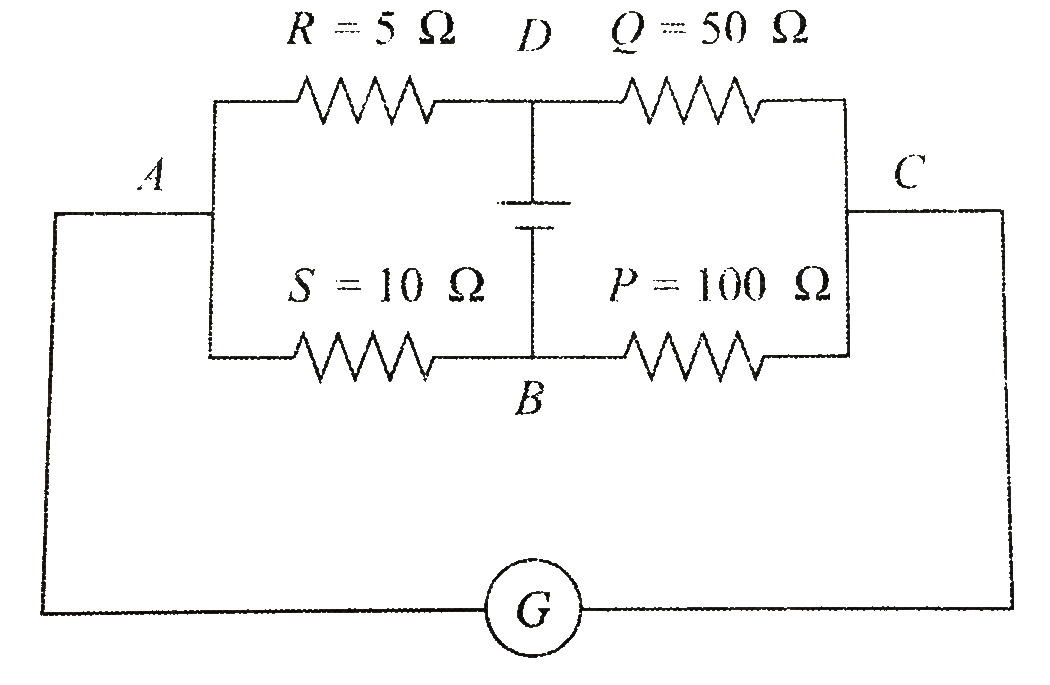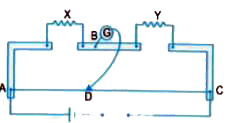If galvanometer and battery are interchanged in balanced wheatstone bridge, then
the battery discharges
the bridges still balances
the balance point is changed
the galvanometer is damaged due to flow of high current.
The correct Answer is:B
To solve the problem of what happens when the galvanometer and battery are interchanged in a balanced Wheatstone bridge, we can follow these steps:
Step 1: Understanding the Wheatstone Bridge
A Wheatstone bridge consists of four resistors arranged in a diamond shape. The bridge is balanced when the ratio of the resistances in one branch is equal to the ratio of the resistances in the other branch. Mathematically, this is represented as:
PQ=RS
Where P, Q, R, and S are the resistances in the respective arms of the bridge.
Step 2: Condition of Balance
In a balanced Wheatstone bridge, the condition can also be expressed as:
P⋅S=Q⋅R
This means that there is no current flowing through the galvanometer when the bridge is balanced.
Step 3: Interchanging the Galvanometer and Battery
When we interchange the galvanometer and the battery, the new configuration will still consist of the same resistances P, Q, R, and S, but the battery will now be connected where the galvanometer was, and vice versa.
Step 4: Analyzing the New Configuration
In the new configuration:
- The battery is connected across the points where the galvanometer was.
- The galvanometer is connected across the points where the battery was.
Step 5: Checking the Balance Condition
Even after the interchange, the ratio of the resistances remains the same:
PR=QS
This implies that:
P⋅S=Q⋅R
Thus, the bridge remains balanced.
Step 6: Conclusion
Since the balance condition is still satisfied after interchanging the galvanometer and battery, we can conclude:
- The bridge is still balanced.
- There will be no current through the galvanometer, hence no battery discharge.
- The balance point remains unchanged.
Final Answer
- The bridge is still balanced.
- There is no battery discharge.
A Wheatstone bridge consists of four resistors arranged in a diamond shape. The bridge is balanced when the ratio of the resistances in one branch is equal to the ratio of the resistances in the other branch. Mathematically, this is represented as:
PQ=RS
Where P, Q, R, and S are the resistances in the respective arms of the bridge.
In a balanced Wheatstone bridge, the condition can also be expressed as:
P⋅S=Q⋅R
This means that there is no current flowing through the galvanometer when the bridge is balanced.
When we interchange the galvanometer and the battery, the new configuration will still consist of the same resistances P, Q, R, and S, but the battery will now be connected where the galvanometer was, and vice versa.
In the new configuration:
- The battery is connected across the points where the galvanometer was.
- The galvanometer is connected across the points where the battery was.
Even after the interchange, the ratio of the resistances remains the same:
PR=QS
This implies that:
P⋅S=Q⋅R
Thus, the bridge remains balanced.
Since the balance condition is still satisfied after interchanging the galvanometer and battery, we can conclude:
- The bridge is still balanced.
- There will be no current through the galvanometer, hence no battery discharge.
- The balance point remains unchanged.
- The bridge is still balanced.
- There is no battery discharge.
Similar Questions
In the meter bridge experiment, a student observes a balance point at the point at the point J, where AJ=l. The value of R and X are both doubled and then interchanged. What will be the new position of balance point. If in this set up, the galavanometer and battery are interchange at the balance point position, how will the balance point get affected?

View SolutionExtended Wheatstone Bridge
View Solution
Knowledge Check
If all four resistance and resistance of a galvanometer are equal to R with equal resistance of wheatstone bridge, then equivalent resistance is:
ARBR4C2RDR2Figure 6.64 shows a balanced wheatstone bridge.
 AIf Pis slightly increased, the current in the galvanometer flows from C to A.BIf Pis slightly increased, the current in the galvanometer flows from A to C.CIf Qis slightly increased, the current in the galvanometer flows from C to A.DIf Q is slightly increased, the current in the galvanometer flows from A to C.
AIf Pis slightly increased, the current in the galvanometer flows from C to A.BIf Pis slightly increased, the current in the galvanometer flows from A to C.CIf Qis slightly increased, the current in the galvanometer flows from C to A.DIf Q is slightly increased, the current in the galvanometer flows from A to C.Wheatstone bridge can be used
Ato compare two unknown resistances.Bto measure small strains produced in hardmetalCas the working principle of meterbridgeDall the above
(i) In a metre bridge, the balance point is found to be at 39.5 cm from the end A, when the resistor Y is of 12.5Ω. Determine the resistance of X. Made of thick copper strips?
(ii). Determine the balance point of the bridge above if X and Y are interchanged.
(iii). what happens if the galvanometer and cell are interchanged at the balance point of the bridge ? Would the galvanometer show any current?
View Solution(a) In a metre bridge the balance point is found to be at 39.5 cm from the end A, when the resistor Y is of 12.5 Ω . Determine the resistance of X. Why are the connections between resistors in a Wheatstone or metre bridge made of thick copper strips ?
(b) Determine the balance point of the bridge above if X and Y are interchanged.
(c ) What happens if the galvanometer and cell are interchanged at the balance point of the bridge? Would the galvanometer show any current ?

View SolutionDerive the condition of balance for Wheatstone bridge.
View SolutionA meterbridge is in balance condition. Now if galvanometer and cell are interchanged, the galvanometer shows no deflection. Give reason.
View SolutionWheatstone Bridge |Questions|Unbalanced Wheatstone Bridge
View Solution
